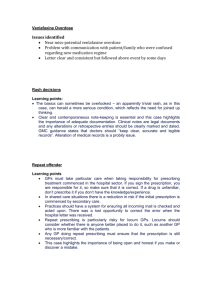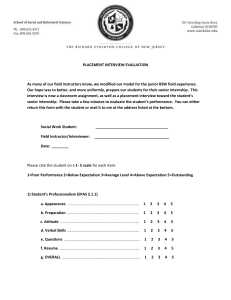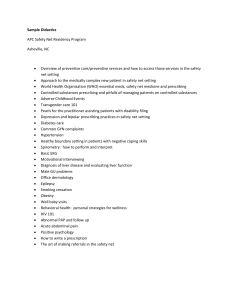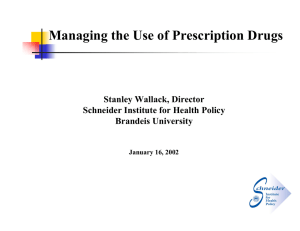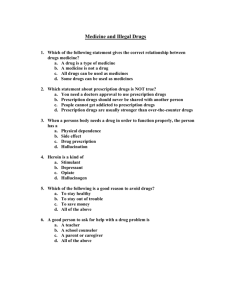Usage Assessment of Electronic Prescribing Application
advertisement
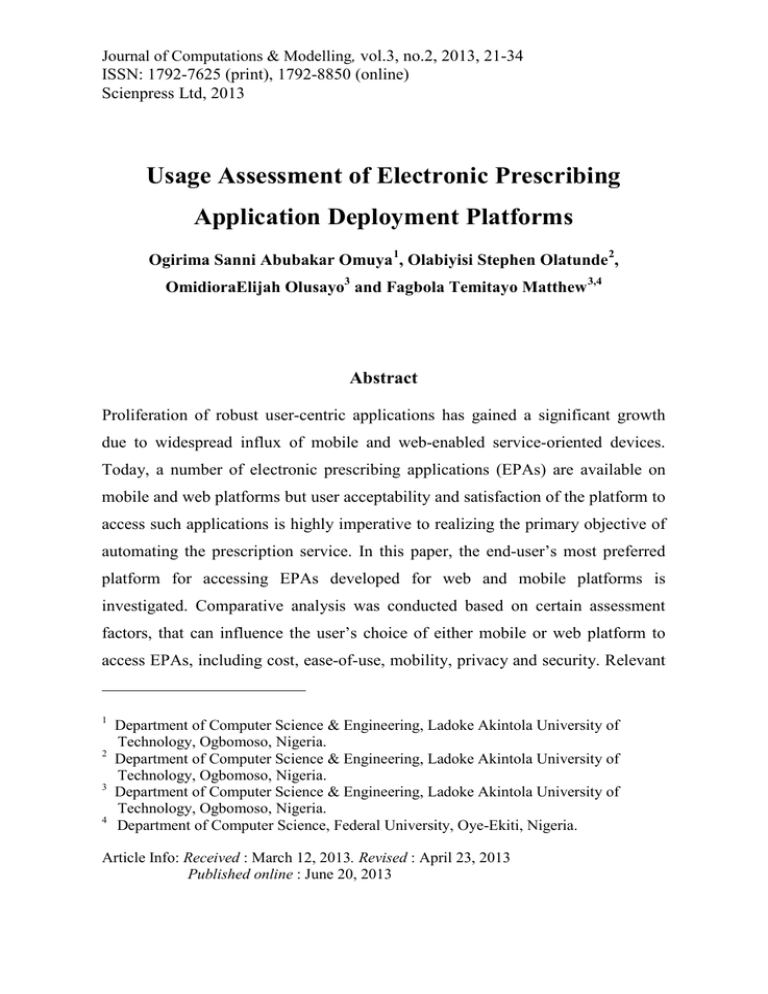
Journal of Computations & Modelling, vol.3, no.2, 2013, 21-34 ISSN: 1792-7625 (print), 1792-8850 (online) Scienpress Ltd, 2013 Usage Assessment of Electronic Prescribing Application Deployment Platforms Ogirima Sanni Abubakar Omuya 1, Olabiyisi Stephen Olatunde 2, OmidioraElijah Olusayo3 and Fagbola Temitayo Matthew 3,4 Abstract Proliferation of robust user-centric applications has gained a significant growth due to widespread influx of mobile and web-enabled service-oriented devices. Today, a number of electronic prescribing applications (EPAs) are available on mobile and web platforms but user acceptability and satisfaction of the platform to access such applications is highly imperative to realizing the primary objective of automating the prescription service. In this paper, the end-user’s most preferred platform for accessing EPAs developed for web and mobile platforms is investigated. Comparative analysis was conducted based on certain assessment factors, that can influence the user’s choice of either mobile or web platform to access EPAs, including cost, ease-of-use, mobility, privacy and security. Relevant 1 2 3 4 Department of Computer Science & Engineering, Ladoke Akintola University of Technology, Ogbomoso, Nigeria. Department of Computer Science & Engineering, Ladoke Akintola University of Technology, Ogbomoso, Nigeria. Department of Computer Science & Engineering, Ladoke Akintola University of Technology, Ogbomoso, Nigeria. Department of Computer Science, Federal University, Oye-Ekiti, Nigeria. Article Info: Received : March 12, 2013. Revised : April 23, 2013 Published online : June 20, 2013 22 Usage Assessment of Electronic Prescribing … data obtained from questionnaires and oral interviews constitute the primary data used for the analysis. Frequency and percentages are the descriptive techniques used to present the results. The results obtained reveal that users prefer mobile platform to web platform in terms of privacy, mobility, cost and security. However, in terms of ease of use, the web platform is preferred to mobile. This paper will assist software developers to make sound and knowledgeable decisions on what electronic platform is best suited to deploy user-centric health-related and EPAs which can account for wider user acceptability and satisfaction derived. Keywords: Electronic Prescribing, Web platform, Mobile platform, Usage Assessment, Assessment Factors 1. Introduction Prescription is a health-care programme that governs the plan of care for an individual patient and is implemented by a qualified practitioner [1]. However, electronic prescribing or e-prescribing is the computer based electronic generation, transmission and filling of a medical prescription, taking the place of paper and faxed prescriptions [2]. E-prescribing allows a physician, nurse practitioner or physician assistant to electronically transmit a new prescription or renewal authorization to a community or mail-order pharmacy. It outlines the ability to send error-free, accurate and understandable prescriptions electronically from the healthcare provider to the pharmacy [2]. E-prescribing is meant to reduce the risks associated with traditional prescription script writing. By sharing medical prescription information, e-prescribing seeks to connect the patients' team of healthcare providers to facilitate knowledgeable decision making. However, medication errors, adverse and potential adverse drug events are Ogirima Sanni Abubakar Omuya et al. 23 common and serious in terms of the harms and costs that they impose on the health system and those who use it [3]. Errors resulting in preventable adverse drug events have been shown to occur most often at the stages of ordering and administration because most prescribers lack the digitized information systems that reduce prescribing errors [4]. Figure 1a: User’s prescription request via Mobile SMS Service Figure 1b: System response to user’s request via Mobile SMS Service 24 Usage Assessment of Electronic Prescribing … To address this, a number of web applications have been developed and linked to prescription databases [5] to pull out appropriate information about adherence levels for different stakeholders; mobile devices, technologies and applications have also been integrated into electronic prescription, electronic validation and dispensation for overall public prescriptions to boost safe and efficient use of medicines [6]. As a result, the digitized information system, otherwise known as the EPA deployed over both web and mobile platforms has really helped to reduce prescription error [2] but research on the user-preferred platform to access such service has never been conducted. A sample mobile and web-based EPA is presented in Figures 1 and 2 respectively. Figure 2a: Ailment Symptoms Page to aid User’s Prescription Request Ogirima Sanni Abubakar Omuya et al. 25 Figure 2b: Patient Ailment Prescription Request Form Figures 1a and 1b [4] present a sample EPA being accessed via a mobile platform while Figures 2a and 2b [7] present a sample EPA being accessed via a web platform. In this paper, a study on the user-preferred platform to access EPAs is carried out. To achieve this, some selected quality assurance assessment metrics including cost, ease-of-use, security / data protection, privacy and mobility are adopted. Results obtained from this study will assist system and software developers to identify user-preferred platforms to access EPAs and make knowledgeable decisions. This will allow further developments and improvements on new and existing models of EPAs to be deployed and made available over user-preferred platforms. 26 Usage Assessment of Electronic Prescribing … 2. Related Works [8] Classified web applications as the fastest growing classes of software systems today. It was argued that web applications are being used to support wide range of important activities such as business transactions, scientific activities like information sharing and medical systems like expert system-based diagnosis. The authors concluded that web applications have been deployed at a fast pace and has gained fast adoption. [6] Investigated the impact of an online prescription management account on medication adherence. Adherence was assessed by measuring the proportion of days covered (PDC). Propensity score matching was utilized to minimize differences in age, gender, chronic condition score, copy, household income and urban locality between the users and non-users groups. Results obtained indicate that patients who utilized an online prescription management account had higher rates of medication adherence as compared with nonusers. It was later concluded that additional studies are needed to assess which specific components of the prescription management account have the biggest impact on adherence. [9] Investigated e-prescribing as a micro-organizational network in search of an analysis framework. He suggested that the organizational form of e-prescribing is a temporal ad-hoc micro-organizational network (MON) centered on the engineered artifact transaction between a single prescriber and a single pharmacy. The author emphasized that each transaction requires a MON, so the structural form of e-prescribing is a network of MONs. The study conclusively summarized that MON for e-prescribing is essential for future care coordination among healthcare organizations as it becomes increasingly computer-mediated. [3] Proposed a randomized control trial designed to evaluate the effectiveness of electronic prescribing in reducing prescription error in an ambulatory setting. The authors argued that internet-based applications and programs may be a way to guide patients toward refilling their medications at proper intervals because the Ogirima Sanni Abubakar Omuya et al. 27 Internet has shaped American society with nearly 70% of households having Internet access at home. They hypothesized that patients who use Internet-based services to fill their prescriptions will have greater rates of adherence. [10] Compared electronic prescribing systems. The authors argued that commercially available electronic prescribing systems may differ in their effects on patients’ health outcomes and on patients’ ability to manage costs. They convened experts’ panel to recommend specific features that would enable electronic prescribing systems to advance these goals. The panel authored sixty recommendations and rated each using a modified Delphi process. In overall, these recommendations offer a synthesis of evidence and expert opinion that can help guide the development of electronic prescribing policy and application development. 3. Materials and Method In this section, the comparative assessment factors, the research questions, the study area and sample size, data collection instrument, method and tools for data analysis for the user-preferred platforms to access EPAs are discussed. 3.1 Comparative Evaluation Factors First, a pilot study, in which a number of personal unstructured interviews with health service providers and patients, was conducted. This was done to discuss the purpose of the research study. Since all factors to investigate users preferred platform to accessing EPAs could be numerous, it implies that given an objective to ensure quality of prescription service and applications, much emphasis must be channeled to the critical factors. These factors are the most important measures relative to high turnaround time, efficiency of service and user 28 Usage Assessment of Electronic Prescribing … satisfaction; therefore preference must be accorded them. These basic factors are independent of one another and can significantly influence the user’s choice of a platform to access EPAs. They include [11]: (a) Security / data protection: When resources in a system come from different, possibly competing, vendors, the openness of the system implies that the level of trustworthiness of information obtained through interactive environment would be low and strong security measures have to be in place to protect devices from one another. Complex system interactions might substantially complicate tracing the information flows to its origin, thus preventing users to judge the reliability of acquired information. Security can be used to measure how reliable and acceptable a system will be. (b) Privacy: A system should offer privacy in terms of confidentiality, integrity and availability to authorized entities. A computational system that ensures privacy for both users and applications in term of intrusion prevention is always preferred. (c) Cost: Cost can be used to evaluate a number of models. A cost-effective model that is functional in nature can be preferred over an expensive one. A model which does not require infrastructure purchase will lower maintenance. (d) Mobility: User mobility refers to the freedom the user has to move about when interacting with the system. Object mobility is required to move services around a network for better load balancing, fault tolerance and high-availability. (e) Ease of Use: A well structured graphical user interface and tool tips to guide the users is highly important. Help files are also tools to help the user get familiarized with the application environment and aid usage knowledge of the technical part of the system. Ogirima Sanni Abubakar Omuya et al. 29 3.2 Research Questions (i) Is accessing EPAs via web more cost-effective than via mobile platform or vice-versa? (ii) Is prescribed drug & patient information more secured on web platform than on mobile platform or vice-versa? (iii) What is the level of privacy when using web or mobile to access EPAs? (iv) What is the level of mobility (accessibility & availability) of the EPAs deployed on web and mobile platform? (v) How easy is it using web or mobile to access EPAs? 3.3 The Study Area & Sample Size The population of the study comprises of the entire health service providers and patients at the LAUTECH teaching hospitals situated in Oyo and Osun States, Nigeria. The health service providers consist of Doctors, Nurses, Midwives, the hospital maids, attendants, nursing and medical students. Consequently, there was adoption of a purposive technique to determine those to be interviewed (sample size) because the population in the study area is large. Purposive sample is drawn to aid the ease of data collection or special features of the members of the sample. Therefore, the selection of the respondents was based on identification made by the health stakeholders in the study area of those who can serve the research purpose. A total of one hundred (100) copies of questionnaire were distributed to these respondents from diverse educational background while ninety-five (95) copies were returned, representing a response rate of 95% as follows: i. Pharmacists = 22 ii. Patients = 32 iii. Nurses / Midwives = 9 iv. Doctors = 11 30 Usage Assessment of Electronic Prescribing … v. Others (Hospital Management staff, Nursing and Medical Students) = 21 The respondents were asked to indicate the factor (s), according to how strong each feels, that can significantly influence the choice of web or mobile platform to access EPAs. 3.4 Data Collection Instrument A well-structured questionnaire and oral interviews were used to gather primary data for the study. The questionnaire was validated and tested for reliability. A Cronbach alpha reliability co-efficient of α = 0.72 was achieved. 3.5 Method and Tools for Data Analysis Microsoft Excel was used to capture and analyze the data obtained from the duly-filled copies of questionnaire while frequency and percentage distributions were the descriptive techniques used. The descriptive survey was adopted to obtain the opinion of a representative sample of the target population so as to be able to infer the perception of the entire population. 4. Result and Discussion The assessment carried out in this work was based on users’ preference of a chosen platform to access EPAs in terms of security, cost, ease of usage, privacy and mobility of the system. In Figure 3, the gender distribution of the respondents is presented; while 68% of the respondents are male, 32% are female. Ogirima Sanni Abubakar Omuya et al. 31 Gender Distribution of Respondents Male Female Figure 3: Gender Distribution of Respondents However, Figure 4 shows the distribution of occupation of the respondents in the study area. The degree of responsiveness of the respondents decreases from the patients, to the pharmacists, the others (management staff of the hospital, the nursing and medical students), the doctors and the nurses in that order. Distribution of Respondents Occupation Doctors Nurses / Midwives Patients Pharmacists Others Figure 4: Distribution of Respondents Occupation The evaluated result obtained from respondents’ data analyzed using Microsoft excel’s descriptive techniques including frequency and percentages, 32 Usage Assessment of Electronic Prescribing … salient factors that can influence users’ choice of a preferred platform to access EPAs, is presented in Figure 5. This result is influenced by the frequency of respondents’ choice of the salient factors that can impact the choice of a preferred platform to access EPAs. 90 80 70 60 50 Mobile 40 Web 30 20 10 0 Cost Ease of Use Mobility Privacy Security Figure 5: Results of Usage Adoption Assessments of Mobile and Web-based Electronic Prescription Services The result indicates that users prefer mobile platform to web platform in terms of cost, security, privacy and mobility in the study area. This result answers the research questions (i), (ii), (iii) and (iv) respectively. Certain reasons that can account for this result could be availability of SMS feature on mobile platform that allows it to be highly emergency compliant; it assists people in the remote area without internet facilities to use their phones to obtain prescriptions on their relative health challenges. However, in terms of ease of use, the web platform is preferred to mobile. This answers the research question (v). This is possible because good graphical user interface feature and other flexible features plug-ins are mostly available for web platforms. Ogirima Sanni Abubakar Omuya et al. 33 5. Conclusion In this paper, user preferred platform to access EPAs is investigated. Privacy, mobility, ease-of-use, security and cost are preferential critical assessment factors considered to impact user’s choice decision. Based on the results obtained from the study, users prefer mobile platform to web platform in terms of privacy, mobility, cost and security. However, in terms of ease of use, the web platform is preferred to mobile. This paper will assist software developers to make sound decision on what electronic platform is best suited to deploy user-centric health-related and EPAs as this will help enhance application availability and wider / global user acceptability. However, future research work can investigate the level of adoption, availability, use and acceptability of EPAs and related applications in primary, secondary and tertiary health-care centres of developing economies. References [1] P.J. Piliero, Editorial comment: fewer prescribing errors in the 21st Century?, AIDS Read 2003, 13(6), (2003), 277, PubMed Abstract. [2] MedRunner Inc., e-Prescribing. Retrieved November 22, 2011, from MedRunner Inc., (2011), http://www.medrunner.ca/learn-more/eprescribing [3] Merrick F. Zwarenstein, Katie N. Dainty, Sherman Quan, Alex Kiss and Neill KJ Adhikari, A cluster randomized trial evaluating electronic prescribing in an ambulatory care setting, Trials 2007, 8, (2007), 28, doi:10.1186/1745-6215-8-28. [4] Ogirima Sanni A.O., Olabiyisi Stephen O., Omidiora Elijah O. and Fagbola Temitayo M., Mobile Oriented System for Prescription in Herbal Medicine, International Journal of Scientific & Engineering Research, 4(2), (February, 2013), 1-10. 34 Usage Assessment of Electronic Prescribing … [5] European Innovation Partnership on Active and Healthy Ageing (EIPAHA), Action Plan on Prescription and Adherence to Treatment, Conference of Interested Partners, Brussels, (6 November, 2012). [6] John G. Hou, Patricia Murphy, MPH; Andrew W. Tang, MS; Nikhil Khandelwal, Ian Duncan and Cheryl L. Pegus, (2012): Impact of an Online Prescription Management Account on Medication Adherence, The American Journal of Managed Care, 15(7), (2012), 437-445. [7] Ogirima, Sanni Abubakar Omuya, Olabiyisi, Stephen Olatunde, Omidiora, Elijah Olusayo, Oke, Alice Oluwafunke, Web-Based Decision Support System for Prescription In Herbal Medicine, Transnational Journal of Science and Technology, 2(11), (December, 2012), 17-33. [8] Arora A. and Sinha M., Web Application Testing: A Review on Techniques, Tools and State of Art, International Journal of Scientific & Engineering Research, 3(2), (February, 2012),1, ISSN 2229-5518. [9] Nelson King, E-Prescribing as a Micro-Organizational Network in Search of an Analysis Framework, First International Workshop on Organizational Design and Engineering (IWODE09), (December, 2009). [10] Douglas S. Bell, Richard S. Marken, Robin C. Meili, C. Jason Wang, Mayde Rosen, Robert H. Brook and the RAND Electronic Prescribing Expert Advisory Panel, Recommendations for comparing Electronic Prescribing Systems: Results of an Expert Consensus Process, Health AFFAIRS Web Exclusive, Project HOPE–The People-to-People Health Foundation, Inc. (2004), doi: 0.1377/hlthaff.W4.305. [11] Olabiyisi O. Stephen, Temitayo M. Fagbola, Ronke S. Babatunde, An Exploratory Study of Cloud and Ubiquitous Computing Systems, World J of Engineering and Pure and Applied Sci., 2(5), (2012), 148-154.
